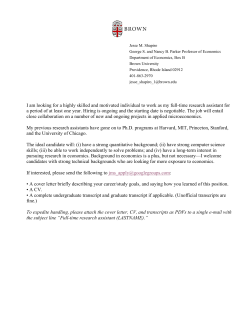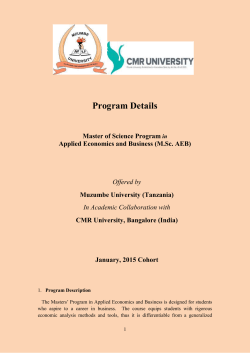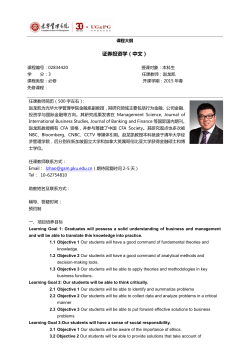
Econ51syllabus_spr15 - Economics
51-S2015 STANFORD UNIVERSITY, DEPARTMENT OF ECONOMICS ECON 51: ECONOMIC ANALYSIS II SPRING 2015 Updated: March 23, 2015 Instructor: Cristian Santesteban, cjs@stanford.edu Office hours: 2-3:30 Course times and location: Tuesday and Thursday 11.00- 12:50pm, room 320-105 Prerequisites: Econ 50 must be completed before you enroll in Econ 51 (Axess will not allow you to enroll otherwise). There are no exceptions for this prerequisite (in particular, you cannot take Econ 50 and 51 concurrently). For more information on prerequisites, please contact the undergraduate administrator Joanne DeMarchena (jdemar@stanford.edu). Since this is a class about microeconomics, it will heavily rely on concepts introduced in Econ 50. If you have taken Econ 50 a long time ago, it may be useful to refresh your memory with its material, using any of the textbooks listed below. In addition to Econ 50, you should be familiar with multivariate calculus and basic probability theory. In particular, you should be able to take derivatives, know some constrained maximization (e.g. be able to solve max(log(x) + log(y)) s.t. x+y=t), and be able to solve simple nonlinear equations. If you do not have a firm mathematical background, this class will be very difficult for you. Course Description: This course will explore selected topics in microeconomic analysis. These will include decisions under uncertainty, general equilibrium, game theory, imperfect competition, and theories of asymmetric information. The theories we will discuss provide the foundation of almost all fields in modern economics, and are therefore essential for almost all upper division courses in economics. The basic question we are trying to answer in this class is: What happens when economic agents (individuals, firms etc.) interact, either in markets or through other institutions? As we will see, the answer to this question depends crucially on what we assume about the form of interaction. This course (as well as almost all modern economics) heavily relies on mathematics, will require much work, and many of you may not find it easy. The recommended strategy is to study continuously, use the problem sets to make sure you keep up with the material, and contact the TAs at the first sign of trouble. There is also a tutoring service provided 1 51-S2015 by the “Center for teaching and learning” (CTL) at Stanford, which you might find useful (the website is http://ctl.stanford.edu/). Economics department common course policies: All courses taught at the Stanford Department of Economics are governed by a common set of course management rules. A document explaining these rules is on the Economics Department website at http://economics/undergraduate/economics-common-syllabus. Please be sure to read this document in its entirety and, if you have any questions, send an email to both me and Joanne DeMarchena (jdemar@stanford.edu), the undergraduate administrator at the economics department. Note that it is your responsibility to get familiar with these policies, and failure to do so does not constitute grounds for exceptions from these policies. Class and Exam Schedule: The class meets on Tuesdays and Thursdays, 11.00-12:50am, room 320-105. I will start at 11:05pm sharp. Regular lectures will take place through Tuesday, June 2. In addition, we will hold a review class on Sunday, June 7th. There will be one midterm exam during class on April 3 0 (at the class t i m e a n d location). The final exam will be on June 9, 3:30-6:30. There will be no make-up exams, and no early or late sittings for exams. In the past, some students asked for make-up exams because of various reasons such as job interviews, family issues, travel plans etc. Even though I completely sympathize with most of these reasons, it is not possible to grant such accommodations under the department rules, and students who miss an exam will obtain a score of zero. Problem sets: Problem sets constitute a major part of the course grade, and an even larger part of your learning. No amount of lecturing and explanations in the class and sections can replace the process of learning by doing, i.e. understanding, internalizing and applying the ideas, that you must go through yourself. It will therefore be hard, and sometimes impossible, to fully grasp the material covered in the lectures without solving the problem sets. They are designed to be challenging, so some parts of them will be more difficult than the level of knowledge required for the midterm or final. Thus, not being able to solve all problem sets in full does not necessarily mean that you cannot do well in the exams. The main benefit of hard exercises is that they make you think and go back to your class notes many times, so along the way your understanding will improve and solving similar problems will become easier over time. I strongly recommend that you study in groups, work on the problem sets in groups, and bring to class or office hours the exercises where you need help - but work on them seriously first (see Office Hours below). When working in groups on the problem sets, you should submit your own write-up nonetheless. There will be six problem sets during the quarter. Problem sets will typically be posted on Tuesdays, and will be due t h e f o l l o w i n g w e e k , in section. If you are out of town 2 51-S2015 or cannot make it to a section, you can submit your problem set earlier. In this case, you have to arrange with your section TA when to hand it over personally (problem sets left in mailboxes or offices/desks will not be considered). No problem set is accepted later than Friday 4:00pm. Late submissions of problem sets will not be accepted, and there are no exceptions for this policy, including even medical emergency or other reasons. However, to allow for the fact that “bad stuff happens,” we will drop one problem set (with the lowest score) when we compute your overall grade. All problem sets, answer keys, and handouts will be available on coursework after the submission deadline. Grading: The grade in the course will be based on three components: problem sets, a midterm exam, and a final exam. The 6 problem sets will be graded on a check-minus, check, check-plus basis. The lowest-grade problem set will be dropped, but I nevertheless strongly recommend submitting all problem sets. The final grade for the course will be a weighted average of the above three components. The weighting system is designed to provide students who did not do well in the midterm an opportunity to do well in the course. For each student, we will calculate two averages. The first will apply weights of 25% to problem sets, 30% to the midterm, and 45% to the final. The second will apply weights of 20% to problem sets, 20% to the midterm, and 60% to the final. Your course grade will be the higher of the two. Thus, in case you do poorly in the midterm, it will only count towards 20% of your final grade, provided that you do well in the final. Email and other online help: Your first resource to obtain help with course-related questions is your TA. You should not hesitate to email or meet them during office hours. In addition, I plan to answer all course-related emails at least three times a week, most often on Tuesdays, Thursdays, and once over the weekend. If you think that your question can be addressed by email, this would be the preferred channel. Of course, I will also hold regular office hours (see the beginning of the syllabus) for issues that are hard to address by email, and necessitate a more interactive dialogue. Office Hours: Your TAs and I offer office hours (OHs) every week. Please make sure to use them wisely. For example, be aware that (i) OHs are not substitutes for lectures: Do not skip lectures, asking the TA to explain the lecture slides in the OH instead, (ii) OHs are not substitutes for study groups: You should not count on your TA to walk through the problem sets before you have tried to solve the problems on your own or in your study group (of course, if you have tried and still have questions you cannot solve, then you are welcome to ask your TA for help). (iii) Some students in the past tried to work on their problem sets during the OH, sitting with the TAs. This is not acceptable, as OHs are intended for actually discussing questions that cannot be resolved in Piazza or by email, not as a substitute for a tutor. You have to be clear about what your question is before coming to the OH so that you can get the most out of it. Texts: The required text is David Besanko and Ronald R. Braeutigam. Microeconomics. 4th Edition. Wiley. You should have this from Econ 50. I will also post my notes used during the class on coursework, and I will make sure that they have 3 51-S2015 sufficient information for understanding the material. For some parts of the class, I will also post handouts from other books on coursework. Other textbooks you might consult are the following: Hal L. Varian. Intermediate Microeconomics. 8th Edition. Norton. Robert S. Pindyck and Daniel L. Rubinfeld. Microeconomics. 7th Edition. Prentice Hall. Walter Nicholson and Christopher Snyder, Microeconomic Theory: Basic Principles and Extensions, Eleventh Edition, South-Western. These books are excellent background readings and provide more intuition and examples, which is complementary to what we cover in class. However, only the material I teach in class and that is covered in the TA sections is relevant for the problem sets and exams. All of the books listed above cover similar material. Nicholson and Snyder is more mathematically rigorous than the other two, so may be closer to what we cover in class. However, I am hoping many of you already own Besanko-Braeutigam from Econ 50; hence my choice for the required book. Students with documented disabilities: Students who have a physical, psychological, or learning disability that may necessitate an academic accommodation or the use of auxiliary aids and services in a class must initiate the request with the Student Disability Resource Center (SDRC), not with the instructor. The SDRC will evaluate the request along with the required documentation, recommend appropriate accommodations, and prepare a verification letter dated in the current academic term in which the request is being made. Students should contact the SDRC in the first week of the quarter as timely notice is needed to arrange for appropriate accommodations. The SDRC is located at 563 Salvatierra Walk. Also see http://www.stanford.edu/group/OAE/ Be sure that you, the SDRC, and I have a common understanding, at least two weeks before any examination, of the precise logistical arrangements by which you will be accommodated. Course outline: I list below the main topics we will cover, the approximate number of lectures we will spend on each topic, and the relevant chapters in the book. On some topics I will supplement with handouts from other books. A more detailed schedule is in a separate handout, also uploaded on Coursework. 1. Monopoly and Market Power (3 lectures): Chapters 11 and 12 2. Game Theory and Strategic Behavior (5.5 lectures): Chapters 13 and 14 3. Time and Uncertainty (2.5 lectures): Chapter 15 (supplemented by handouts) 4. Information Economics (3 lectures): Chapter 15 (supplemented by handouts) 5. General Equilibrium (2 lectures): Chapter 16 6. Externalities and Public Goods (2 lectures): Chapter 17 4
© Copyright 2025










